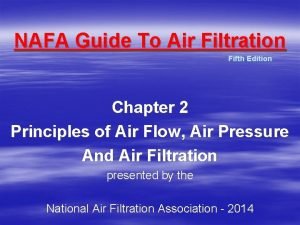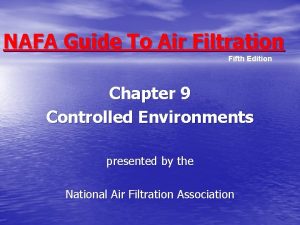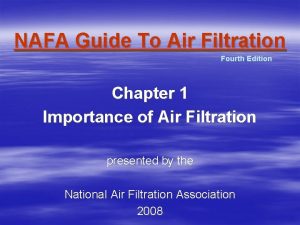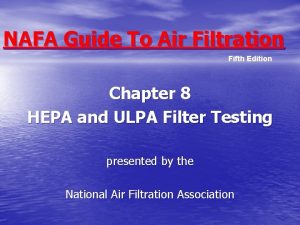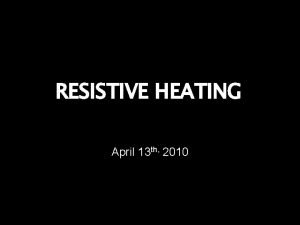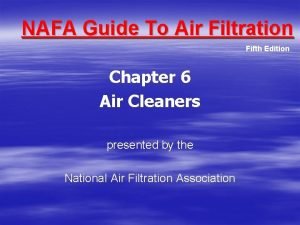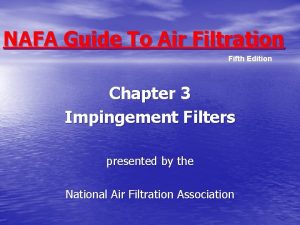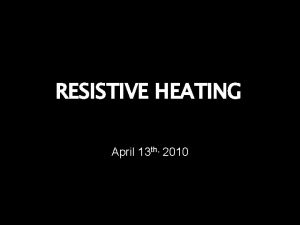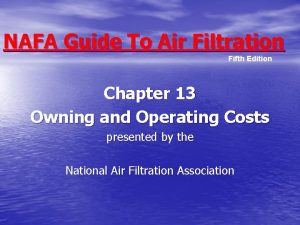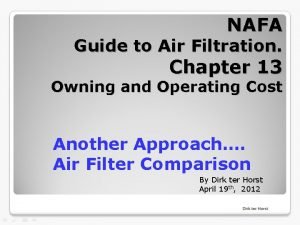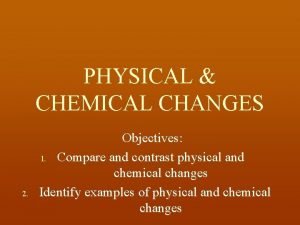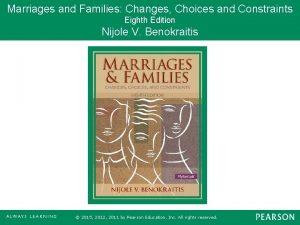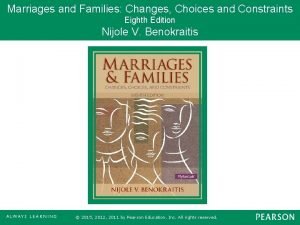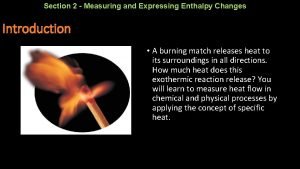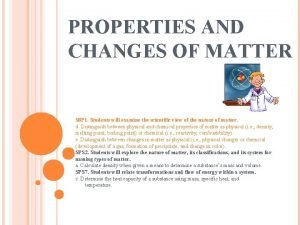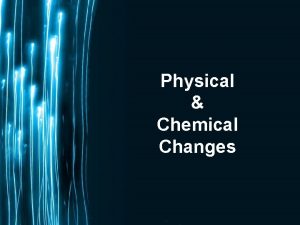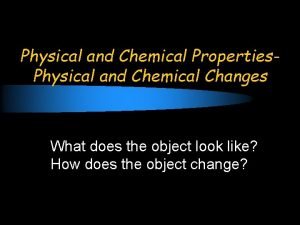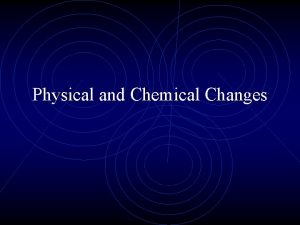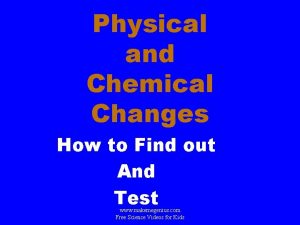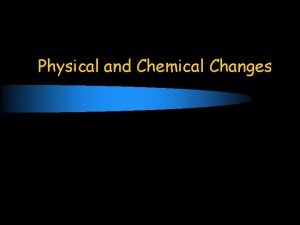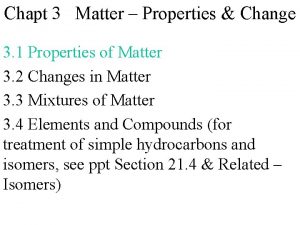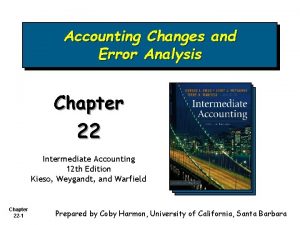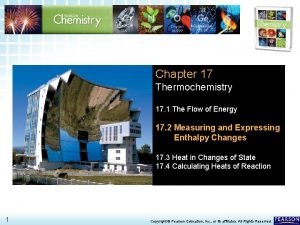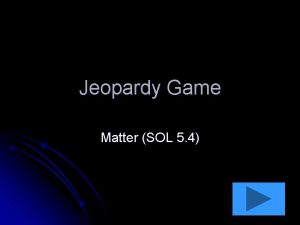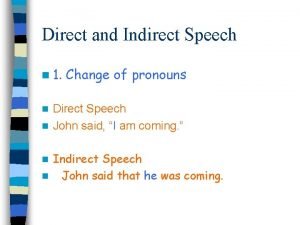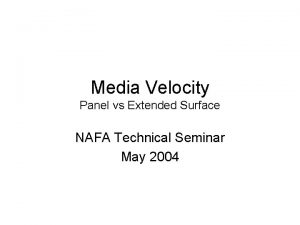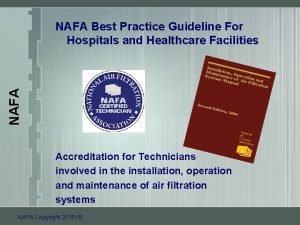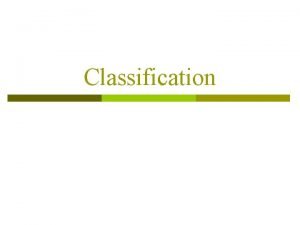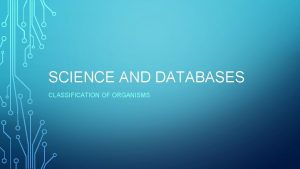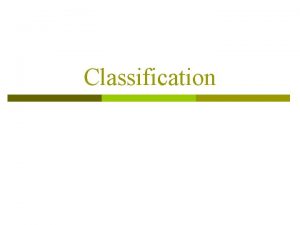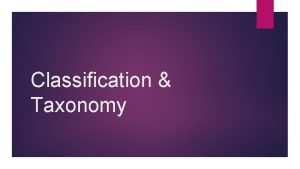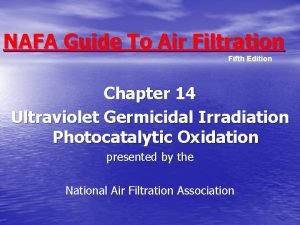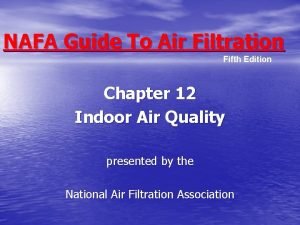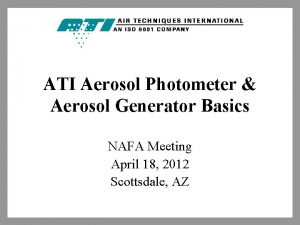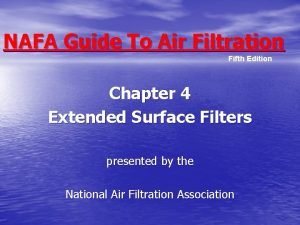UL Classification and Current Changes NAFA 2010 Technical

















































- Slides: 49

UL Classification and Current Changes NAFA 2010 Technical Seminar Louisville, KY April 23, 2010 1

Overview • Scope of UL 900 • Behind the UL Mark • Classification Testing • Field Inspection • Follow Up Testing • Current UL 900 Standard • Upcoming Changes • Future Work to be Done 2

UL 900 Air Filter Units 3

Scope of UL 900 Air Filter Units • The First Edition of UL 900 was issued in September of 1965 • The Current Edition is the Seventh Edition which was issued on September 2, 2004 • ANSI/UL 900 -2009 consists of the Seventh Edition plus revisions through November 6, 2009 • The current revision does not go into effect until May 31, 2012 as noted in the specification 4

Scope of UL 900 Air Filter Units, cont. • From the current effective standard • “cover tests to determine combustibility and the amount of smoke generated for air filter units of both washable and throwaway types used for removal of dust and other airborne particles” • “since the combustibility and smoke generation of an air filter unit, after a period of service, depends upon the nature and quantity of the material collected by the filter, the test requirements of this standard, for classification purposes, apply only to air filter units in a clean condition. ” 5

Caution When Reading the Standard or UL Standard Reading 101 • UL does not update the latest revision level date on all pages of the standard • Some dates will be for previous issues • Latest revision changes are indicated by vertical lines in the left or right margin • The last two pages of the revision is a summary of the Superseded Requirements • A reference for what was changed • Page numbers are indicated by “sr#” 6

What is Behind the UL Mark? 7

The Current UL Mark • Current UL Classified Mark • Composition and Element • Class 1 or Class 2 Classification • Control Number Complete Marking includes: • Company Name or File Number • Product Designation • Plant Identification Code AIR FILTER UNIT AS TO FLAMMABILITY ONLY CLASS 1 / CLASS 2 XXXX (Control No. ) 8

What goes into UL Classification? • The Life Cycle of a UL Classified Product • Classification Testing • Class 2 Testing • Class 1 Testing • Construction Changes • Field Inspection • Follow Up Testing 9

Flame Exposure Test Apparatus • Air Duct with a blower at one end • Allows for the installation of an air filter unit • Allows for exposure of the air filter unit to an igniting flame under controlled conditions of air velocity • Provides means for observation of the sample filter, and the observation of flame, sparks, and smoke 10

Test Duct Details • Accommodates filters nominal 20 x 20 and nominal 24 x 24 with an adapter section • Adapter plates for filters smaller than nominal 20 x 20 • Length of discharge end of the duct is 8 feet measured from downstream face of the filter to end of the duct • Access doors and observation windows on the sides of the duct • Two gas nozzles, 11” apart and 2” off duct floor • Photoelectric cell mounted 12” from end of duct and constant light source to measure smoke generation 11

UL Northbrook Test Duct 12

Classification Testing to UL 900 • Class 2 Classification • Shall not produce flame which is sustained beyond the end of the test duct • Shall not produce extensive (25 or more) sparks which are sustained beyond the end of the test duct • Shall not cause the development of an area of more than 58 cm 2 (9 square inches) as measured below the smoke-density time curve • Spot flame test not required 13

Classification Testing to UL 900, cont. • Class 1 Classification • Shall not produce flame • Shall not produce sparks • Shall not cause the development of an area of more than 16. 1 cm 2 (2. 5 square inches) as measured below the smoke-density time curve • Spot flame test required 14

New Product Testing • To Classify a New Class 2 Product • 5 Passing Flame Exposure Tests per Class 2 requirements • To Classify a New Class 1 Product • 5 Passing Flame Exposure Tests per Class 1 requirements • 1 Spot Flame Test testing in 5 separate filter locations 15

Testing for Construction Changes • Major Changes • Class 1 and Class 2 • Same as for New Product • Minor Changes • Class 2 • 3 Passing Flame Exposure Tests per Class 2 requirements • Class 1 • 3 Passing Flame Exposure Tests per Class 1 requirements • 1 Spot Flame Test testing in 5 separate locations 16

Spot Flame Test • 5 locations are tested: frame, media, adhesive • Tested in locations where the flame exposure does not reach • A tip of the blue cone of a gas flame of a Bunsen burner is directed against the upstream face of the sample • Flame adjusted such that it has a 2. 5” blue cone, tip temperature 954± 27°C(1750± 50°F) • Flame is applied for 1 minute then removed. • Filter shall not continue to flame after removal of the test flame to pass 17

Spot Flame Tests 18

Detail of a Spot Flame Test 19

Flame Exposure Test • Air flow is adjusted so that average approach velocity in the duct and the filter face is 220 feet per minute • 612 CFM for nominal 20 x 20, 880 CFM for nominal 24 x 24 • Flow adjusted so discharge velocity is 1 m/s for a nominal 20 x 20 and 1. 4 m/s for a nominal 24 x 24 • Test firing period is 3 minutes • Observations include: condition of both filter faces; density, duration, and character of products of combustion downstream; extent of travel of any flame or sparks beyond the end of the duct • The smoke-density apparatus measures microamperes and the measurement is plotted over time. • Sparks are counted visually at the end of the test duct or by covering the end of the test duct with cheesecloth 20

Flame Exposure Test on Pleated Filter 21

Failed Developmental Flame Exposure Test 22

Field Inspection • • Quarterly Inspections at each Manufacturing Location Inspector compares current production to UL File Inspection annually of all products manufactured Inspection Includes: • Process • Materials Used • • Material Designation Supplier/Vendor/Manufacturer Amount of material Used How materials are measured and check that measurement equipment used is calibrated as required per UL Calibration Requirements 23

Field Inspection, continued • Product Marking • • UL mark Composition and Element Product Designation Company Name or File Number • Multiple Listed Product Checks • Split-Inspection Product Checks • Selection of Follow Up Testing Samples 24

Variation Notices • Any deviation from the UL file can lead to a Variation Notice • Variation Notices and Impact are given and the discretion of the inspector for any non-conformances. • Outcomes can include: • • • Temporary Acceptance of Item(s) affected Product Hold on Items that are UL marked Requiring removal of UL marking from manufactured products Rework of affected items Re-inspection 25

Variation Notices, continued • Manufacturer must identify root cause of Variation Notice and address the issue listed • UL requires a response to the Variation Notice within a specified amount of time • Correct Issue with production or on product • Test alternate materials/construction • Request a file change • Variation Notice Fine • Additional required inspections also incur the standard inspection fee 26

Follow Up Testing • Samples supplied for Follow Up Testing annually • Two samples are required of every type of classified product that each manufacturing location produces • Samples are selected during Field Inspection from current manufacturing or current stock • Each sample is tested for Flame Exposure • Failing one test results in a Variation Notice • The submission of a second set of samples is required • A second failure leads to de-classification of the product 27

Summary of What is Behind UL Marking • Filter Testing • Flame Exposure Testing • Spot Flame Testing • New and Modified Products • Field Inspections • Follow Up Testing Questions? 28

The Current UL 900 Standard 29

The Current UL 900 Standard • In November of 2009, UL issued a revision to the ANSI/UL 900 • Changes go into effect on May 31, 2012 • The changes were made after almost a year of work by the Standards Technical Panel (STP) 900 which includes members of the Air Filtration Industry in various Interest Categories: • Producer, Testing and Standards Organizations, Supply Chain, AHJ (Authorities Having Jurisdiction, regional or local authorities), Government, Consumer, General Interest, Commercial/Industrial Users, International Delegates 30

History of the Latest Revision • Proposed by the Industry Group for Air Filter Units • It was noted that Class 1 designation implies a level of protection that is not supported by any test data • Any difference between Class 1 and Class 2 filters are only distinguishable while the filters are tested in the clean state • Once filters are put into service, Class 1 and Class 2 filters behave similarly • Back to the Scope of UL 900, these requirements “apply only to air filter units in a clean condition. ” 31

The Current UL 900 Standard • What is the Impact of the Current UL 900 Standard? • Depends who you ask • • • UL Standards Committee Members Manufacturers UL Engineers UL Field Inspectors Underwriters Laboratories of Canada (ULC) Air Filter Distributors 32

UL 900 Changes • Removal of Class 1 and Class 2 references • Products will now just be “UL Classified. ” • Classified Products will be tested to current Class 2 standards only. • Spot flame testing will no longer be required • Until the effective date of May 31, 2012, air filters may still be marked Class 1 or Class 2 33

Class 1 and Class 2 Flame Exposure Class 2 (New Classified) Class 1 (Discontinued) • No flame beyond the end of the test duct • Less than 25 sparks sustained beyond the end of the test duct • Less than 9 square inches of smoke measured below the smoke-density time curve • No flame produced • No Sparks • Less than 2. 5 square inches of smoke measured below the smoke-density time curve 34

New Proposed Marking • Currently PROPOSED Only • UL is still in approval stage • Composition and Element • No Classification wording • Control Number AIR FILTER UNIT Complete Marking includes: • Company Name or File Number • Product Designation • Plant Identification Code AS TO FLAMMABILITY ONLY XXXX (Control No. ) 35

Standard Effective Date May 31, 2012 • 40 months from the issue of the revision in November 2009, was given to allow Manufacturers time to bring their air filter markings into compliance with the new requirements • All instances must be updated • Labels, die cuts, printing • Additionally: literature, specifications, Customers • Bolder UL Mark – Changed December 15, 1997 • Compliance extension to December 31, 2010 36

Manufacturers: Between a Rock and a Hard Place • Manufacturers must be in compliance with the Standard by May 31, 2012 • However, Field Inspections are made to the current UL File Classification Marking Page (Class 1/Class 2) • Testing is currently being done is to the current standard (Classified only) • The official marking has not been finalized. • On April 7, UL announced the Industry File Review • Dual Classified Products are a big question mark 37

What’s up with our Friends to the North? 38

Underwriters Laboratories of Canada (ULC) • ULC and UL have a poorly understood relationship • Canadian Standard ULC-S 111 -07 Standard Method of Fire Tests for Air Filter Units • There are subtle differences between ULC-S 111 -07 and UL 900 • Canadian Requirements Comparison Guide CRG 900, issued September 2, 2004 compares UL 900 Seventh Edition and ULCS 111 (1995), written by UL • Filters tested at nominal (maximum) rated capacity air flow • Surgical gauze placed at the end of the duct for spark count • Surgical gauze cannot ignite from sparks or flames • Slight differences in duct configuration 39

Current UL/C-UL Marking • UL Files Only • C on the left, US on the right • Canadian only does not have “US” on the right • Class 1 or Class 2 Classification • Control Number AIR FILTER UNIT Complete Marking includes: • Company Name or File Number • Product Designation • Plant Identification Code AS TO FLAMMABILITY ONLY CLASS 1/CLASS 2 XXXX (Control No. ) 40

How does the change to UL 900 affect Dual Classified Filters? • The ULC-S 111 -07 standard has not changed • Filters still Classified to Class 1 and Class 2 • The Fire Test Committee controls the Canadian Standard • November 2009 meeting conclusion was that they will not change the Canadian Standard just because UL 900 has changed • Require safety or technical reasons for the change • Will be discussed again in the Spring/Summer meeting • Hopefully, more support from UL • Further uncertainty in marking products 41

UL Proposed UL/C-UL Marking • UL Files Only • Dual UL/C-UL Symbol • No Marking Classification in top portion • Control Number • Class 1 or Class 2 notation for ULC-S 111 Complete Marking includes: • Company Name or File Number • Product Designation • Plant Identification Code AIR FILTER UNIT AS TO FLAMMABILITY ONLY XXXX (Control No. ) Class 1/Class 2 in accordance with ULC-S 111 42

UL 900 Mentioned in other Standards • NFPA 90 A (2009), Standard for the Installation of Air. Conditioning and Ventilating Systems, and the International Mechanical Code (2006) both reference UL 900 but UL has determined that this change will not adversely affect either of these codes • There a few instances in NFPA 37, Standard for the Installation and Use of Stationary Combustion Engines and Gas Turbines, where UL 900 Class 1 filters are specified • Other National, State, Local Building Codes, Customer Specifications • Canadian Building Codes call for Class B (Class 2) 43

Future Work for UL and the Air Filtration Industry • • Finalize Marking for US only Classification Work further with ULC to finalize Dual Marking Work further with ULC to change ULC-S 111 -07 Standard Further characterize how the change in UL 900 will affect other standards • Need to develop a unified statement to other regulating bodies • Review Specifications and Standards • Potential Revision regarding clarification of Test Air Flow • UL 900 Clause 7. 27: add “airflow” so the test “approach velocity airflow in the duct at the face of the filter is 220 fpm…” 44

Summary on Changes to UL 900 • UL 900 latest revision removes Class 1 and Class 2 references • Revision is effective May 31, 2012 • Until this date filters may continue to be marked Class 1 and Class 2 • Canadian requirements have not changed so filters still need to be marked Class 1 and Class 2 for Canadian Classification • Distributors can sell filters no matter how they are marked, however be prepared to explain what is happening to Customers 45

UPDATE • April 7, 2010, UL sent out a letter to all filter manufacturers with UL 900 Classification • The letter announced the Industry File Review for UL 900 and requires all manufacturers to contact UL by November 30, 2011 to update their files to the latest UL 900 revision (removing Class 1 and Class 2). • UL suggests to manufacturers that this be done sooner than later • Also, manufacturers should request that their Engineer put a descriptive statement in the report to allow for mixed markings during Field Inspections 46

So we end with a bang! Another Failed UL Test 47

Conclusions • Always stand BEHIND your UL Engineer when witnessing tests • Boring UL burns – GOOD • Exciting UL burns – BAD • Level of Outcomes of UL Testing • • • Pass Fail Room Clearing Event Getting the Hose Out Kevin Getting out his Facemask Damaging or otherwise affecting equipment in the Test Room 48

Questions? Thank you! Shelby Calvert scalvert@filtrationgroup. com 815 -774 -1289 49
 Elizabeth mulroney
Elizabeth mulroney Example of a chemical change
Example of a chemical change Nafa guide
Nafa guide Nafa guide to air filtration
Nafa guide to air filtration Nafa guide to air filtration
Nafa guide to air filtration Penatrometer
Penatrometer Nafa 120v3
Nafa 120v3 Nafa guide to air filtration
Nafa guide to air filtration Impingement filter
Impingement filter Nafa 120v3
Nafa 120v3 Nafa filtration
Nafa filtration Nafa guide to air filtration
Nafa guide to air filtration Line current and phase current
Line current and phase current Difference between phase voltage and line voltage
Difference between phase voltage and line voltage Drift current and diffusion current
Drift current and diffusion current Line current and phase current
Line current and phase current Drift current and diffusion current in semiconductor
Drift current and diffusion current in semiconductor What is diffusion current and drift current
What is diffusion current and drift current In a y-connected source feeding a ∆-connected load,
In a y-connected source feeding a ∆-connected load, Infineon
Infineon Diffusion current formula
Diffusion current formula The jfet always operates with
The jfet always operates with Amperage can be described as
Amperage can be described as Touch current vs leakage current
Touch current vs leakage current Mesh current method with current source
Mesh current method with current source Physical change
Physical change Marriages and families changes choices and constraints
Marriages and families changes choices and constraints Marriages and families changes choices and constraints
Marriages and families changes choices and constraints Qualitative classification in statistics
Qualitative classification in statistics Current and future trends of media and information drawing
Current and future trends of media and information drawing Measuring and expressing enthalpy changes
Measuring and expressing enthalpy changes Properties and changes of matter worksheet
Properties and changes of matter worksheet Physical and chemical changes
Physical and chemical changes Physical and chemical changes
Physical and chemical changes Physical and chemical changes
Physical and chemical changes Generation genius physical and chemical changes
Generation genius physical and chemical changes Physical and chemical changes
Physical and chemical changes Examples of physical vs chemical changes
Examples of physical vs chemical changes Difference between physical change and chemical change
Difference between physical change and chemical change Chemistry matter and its changes
Chemistry matter and its changes Matter-properties and changes answer key
Matter-properties and changes answer key Chapter 22 accounting changes and error analysis solutions
Chapter 22 accounting changes and error analysis solutions Lesson 2: measuring and expressing enthalpy changes
Lesson 2: measuring and expressing enthalpy changes Which is true about chemical change
Which is true about chemical change Summary sentence starters
Summary sentence starters Whats the difference between physical and chemical change
Whats the difference between physical and chemical change Physical and chemical changes jeopardy
Physical and chemical changes jeopardy Baking is a chemical change
Baking is a chemical change Transform direct speech to indirect speech
Transform direct speech to indirect speech Chemical properties and changes lesson 4
Chemical properties and changes lesson 4


